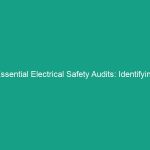Introduction
In today’s fast-paced work Environment, the importance of Health, Safety, and Environment (HSE) cannot be overstated. Workplace Safety is not just a regulatory requirement; it is a fundamental aspect of promoting a productive and efficient work culture. One of the most common tools found in various workplaces are extension cords and electrical tools. Understanding the safe use of extension cords and electrical tools can help prevent accidents and injuries, ensuring that employees return home safely at the end of the day. This article aims to provide essential guidelines that will enhance Safety and compliance when using these tools.
Regulatory Frameworks
Before diving into Best Practices, it’s crucial to understand the regulatory frameworks that govern the use of electrical tools and extension cords. Various organizations and Regulations, such as the Occupational Safety and Health Administration (OSHA) in the United States and similar bodies worldwide, set forth Standards to ensure safety in the workplace.
osha Standards
OSHA outlines specific regulations concerning the use of electrical equipment in the workplace. These standards include:
- General Duty Clause: Requires employers to provide a workplace free from recognized Hazards that could cause death or serious physical harm.
- Electrical Safety Standards: Mandates the proper use of electrical tools, including grounding, circuit protection, and Maintenance of equipment.
- Training Requirements: Employers must provide adequate Training regarding the safe use of extension cords and electrical tools.
Compliance with these regulations not only protects employees but also minimizes legal risks for employers.
International Standards
In addition to OSHA, international standards such as those established by the International Electrotechnical Commission (IEC) provide guidelines that can be adopted globally. These standards focus on equipment safety, electromagnetic compatibility, and risk management, ensuring that electrical tools are safe for use across different environments.
Best Practices for Safe Use
Implementing Best Practices is essential in ensuring the safe use of extension cords and electrical tools. Here are some important guidelines to follow:
Regular Inspection
Before using any extension cords or electrical tools, conducting a thorough inspection is vital. Look for:
- Frayed or damaged wires
- Loose connections
- Discoloration or burn marks on plugs
- Signs of water damage or exposure to moisture
Any defective equipment should be removed from service and repaired or replaced immediately.
Proper Usage
Extension cords are often misused, leading to hazardous situations. To promote Safe Usage:
- Use extension cords that are rated for the intended load and purpose.
- Avoid daisy-chaining multiple extension cords, as this can overload circuits.
- Do not run extension cords through doorways or windows where they can be pinched or damaged.
- Keep extension cords away from heat sources, water, and foot traffic.
Proper Storage
When not in use, extension cords and electrical tools should be stored properly. Avoid wrapping cords tightly around objects, as this can cause internal damage. Instead, loop them loosely and store in a dry, cool area to prevent wear and tear.
Case Studies: Learning from Incidents
Real-world incidents can offer valuable lessons regarding the safe use of extension cords and electrical tools. Here are a few case studies that highlight the consequences of neglecting safety protocols:
Case Study 1: Office Fire
In 2018, an office building experienced a fire caused by an overloaded extension cord. The cord was connected to multiple high-wattage devices, leading to overheating. Fortunately, the fire alarms functioned properly, and all employees evacuated safely. This incident resulted in extensive damage and reinforced the need for adhering to proper electrical standards.
Case Study 2: Construction Site Accident
A construction worker suffered an electrical shock while using a faulty power tool connected to a damaged extension cord. The worker was hospitalized but recovered. Following the incident, the construction company implemented stricter Safety Measures, including regular training and inspections of electrical tools and cords.
Challenges in Ensuring Safety
Despite the best intentions and regulations in place, several challenges persist in ensuring the safe use of extension cords and electrical tools. These include:
Employee Compliance
Even with training, employees might not always follow safety protocols. Some may take shortcuts or overlook inspection steps due to time constraints or lack of understanding. Regular refresher training sessions can help reinforce the importance of compliance.
Equipment Accessibility
In many workplaces, electrical tools and extension cords are readily available, making it easy for employees to use them without proper guidance. Establishing controlled access to equipment and providing clear instructions can help mitigate risks.
Future Trends in Electrical Safety
As technology advances, so do safety practices. The future of the safe use of extension cords and electrical tools may include:
Smart Technology Integration
Smart tools equipped with sensors can alert users to potential Hazards, such as overheating or overloads. This technology can provide real-time feedback, ensuring that users adhere to safety protocols.
Increased Training Opportunities
With the rise of online platforms, training for safe electrical tool usage is becoming more accessible. Companies can provide interactive modules that allow employees to learn at their own pace, ensuring comprehensive understanding and compliance.
Conclusion
In conclusion, the safe use of extension cords and electrical tools is paramount in creating a safe workplace. By understanding regulatory frameworks, implementing best practices, learning from past incidents, and facing the challenges head-on, organizations can foster a culture of safety. Regular training and awareness can empower employees to prioritize safety in their daily tasks, preventing accidents and ensuring a productive work environment. We encourage all organizations to review their safety protocols and commit to ongoing education in HSE to protect their most valuable asset: their employees.


